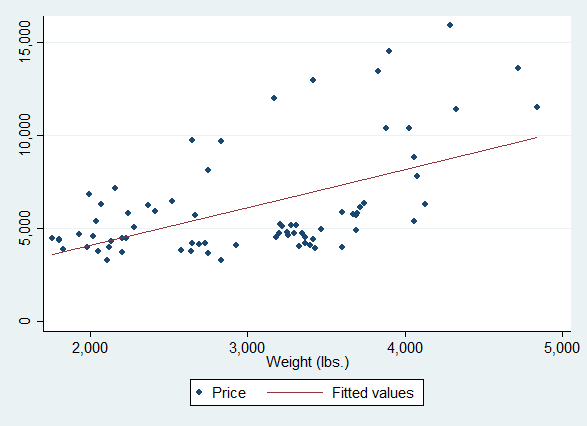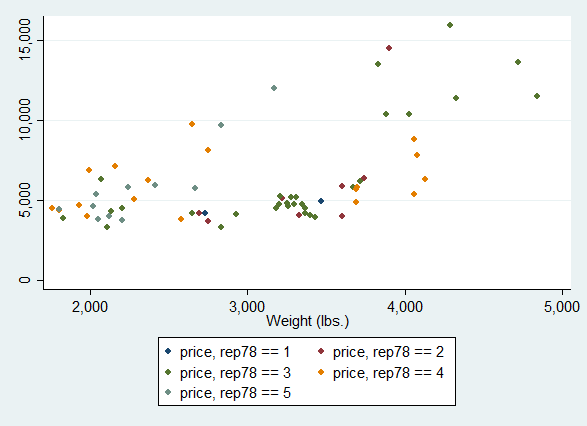Introduction
Producing statistical graphs in Stata revolves around the graph commands.
Type help graph in Stata to see a quick overview of these commands.
In order to draw any graph in Stata you need to specify three things: what graphical elements you want to use in your graph, how these elements will be related to your data, and what kind of scales will be used to position them on the page.
I've stated this abstractly, but in practice this is actually pretty easy - you pick the appropriate graph command and specify the appropriate variable names. Typical examples might look like
graph bar var
graph twoway scatter yvar xvar
graph box zvarWhile there are many other features of graphs that we might want to specify or customize, these three concepts are what it takes to get started - graphical element, data, scale (level of measurement). Everything else about a graph has some default value that we can come back and consider later.
Graphical Elements
At a basic level these are just things like points, line segments, or bounded areas (like polygons). More complicated graphical objects can be constructed out of these basic elements. Stata's graph command will make it easy to specify simple elements as well as treating more complicated objects as fundamental - objects like histograms and boxplots.
Link to Data
The graphs we will consider in Stata are all two-dimensional representations of data. Sometimes elements like points are just positioned in the graph by Cartesian coordinates given by the data values themselves, but other times a point might be given its position by some summary of the data like a group mean. So it can be useful to distinguish between the data set, and the graph-data set. For things like simple scatter plots, these will be one-and-the-same.
Scales (Level of Measurement)
In order to position graphical elements on a page or screen we need some sort of coordinate system. This mainly means Cartesian coordinates. However, Stata will also allow us to distinguish between continuous (Cartesian) scales and categorical scales. Again, this sounds a little abstract, but in practice it is pretty easy.
Some Examples
All of this will be a little more concrete if we look at some examples. We'll start by setting up a familiar data set, auto.
sysuse auto, clear
* Create a categorical variable
generate maker = substr(make, 1, strpos(make, " ")-1)
replace maker = make if strpos(make, " ")==0
label variable maker "Manufacturer"Consider two graphs. Both use points (dots) as graphical elements to visually represent the data.
graph twoway scatter price weight
* scatter price weight // abbreviated version
graph dot price, over(maker)
Scatter plot
Here the graphical elements are the points. The position of each point is determined by a pair of data values, the car weight value and the car price value. These data values are used "as is", as they occur in the data set, untransformed. The number of points is (in principle) the same as the number of observations. Both the x- and the y-values are plotted along continuous scales.

Dot plot
In this second graph, the graphical elements are again points. However the vertical position of each point is given by a distinct category, the car maker. The horizontal position of each point is given by a summary statistic, the mean of the prices of cars from a given maker. The number of points is the number of car makers, not the number of observations. The x-values are on a continuous scale, while the y-values are on a categorical scale (as we will see later, Stata switches the "x-" and "y-" nomenclature).
In order to plot the points, the software generates a graph data set (which we never actually see).
Exercises
Use help graph to find commands you may need.
- Create a bar chart of price versus auto maker. What type of scales are used? Is the height of each bar given by a data value or derived from the data? Use Help to make a second graph where the bars are horizontal.
- Create a scatterplot matrix of price, weight, and mpg. How many points are shown?
- Create a boxplot of mpg (gas mileage) versus rep78 (repair record, a Likert scale). What kind of scales are used for graphing? Although each "box" is treated as a fundamental graphical object, it's relation to the data is a little complicated. How are the mid-line, the length of the box, and the length of the whiskers related to the data: data values or derived statistics? The points that appear above one of the boxes?
- Make a vertical dot plot of price versus rep78. Then make a scatter plot of price versus rep78. How are they similar and how are they different (graphical elements, data, scales)? Why might you prefer one or the other?
- Bonus. Continuing from exercise (4), you cannot simply overlay a dot plot and a scatter plot, but just a little data manipulation would allow you to create a visual combination of the two. Do it! (Hint: if you are stuck, come back to this after reading the next section.)
- Bonus. Histograms are a little more complicated than one might think. Make a histogram of auto prices. What kind of scales are used? How is the y-scale related to the data? The x-scale?



